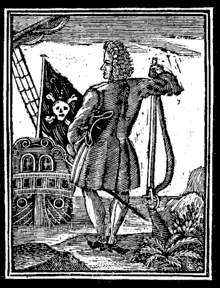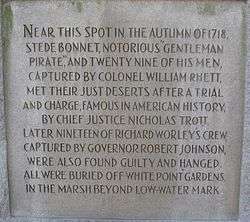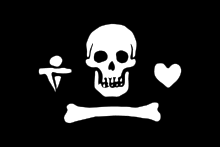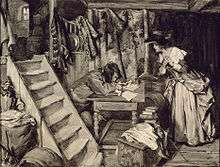Stede Bonnet
Stede Bonnet (1688[1] – 10 December 1718)[2][3] was an early eighteenth-century Barbadian pirate, sometimes called "The Gentleman Pirate"[4] because he was a moderately wealthy land-owner before turning to a life of crime. Bonnet was born into a wealthy English family on the island of Barbados, and inherited the family estate after his father's death in 1694. In 1709, he married Mary Allamby, and engaged in some level of militia service. Because of marital problems, and despite his lack of sailing experience, Bonnet decided he should turn to piracy in the summer of 1717. He bought a sailing vessel, named it Revenge, and travelled with his paid crew along the Eastern Seaboard of what is now the United States, capturing other vessels and burning other Barbadian ships.
Stede Bonnet | |
|---|---|
 Engraving of Bonnet from A General History of the Pyrates (1724) | |
| Born | 1688 |
| Died | 10 December 1718 (aged 29–30) |
| Spouse(s) | Mary Allamby
( m. 1709; died 1714) |
| Piratical career | |
| Nickname | The Gentleman Pirate |
| Type | Pirate |
| Allegiance | None |
| Years active | 1717–1718 |
| Rank | Captain |
| Base of operations | Atlantic Ocean, along East Coast of the British Colonies, and Caribbean Sea |
| Commands | Revenge, later renamed Royal James |
| Battles/wars | Battle of Cape Fear River |
Bonnet set sail for Nassau, Bahamas, to the haven for pirates known as the "pirates' republic", but he was seriously wounded en route during an encounter with a Spanish warship. After arriving in Nassau, Bonnet met Edward Teach, the infamous pirate Blackbeard. Incapable of leading his crew, Bonnet temporarily ceded his ship's command to Blackbeard. Before separating in December 1717, Blackbeard and Bonnet plundered and captured merchant ships along the East Coast. After Bonnet failed to capture the Protestant Caesar, his crew abandoned him to join Blackbeard aboard the Queen Anne's Revenge. Bonnet stayed on Blackbeard's ship as a guest, and did not command a crew again until summer 1718, when he was pardoned by North Carolina governor Charles Eden and received clearance to go privateering against Spanish shipping. Bonnet was tempted to resume his piracy, but did not want to lose his pardon, so he adopted the alias "Captain Thomas" and changed his ship's name to Royal James. He had returned to piracy by July 1718.
In August 1718, Bonnet anchored the Royal James on an estuary of the Cape Fear River to careen and repair the ship. In late August and September, Colonel William Rhett, with the authorization of South Carolina governor Robert Johnson, led a naval expedition against pirates on the river. Rhett and Bonnet's men engaged in combat for hours, but the outnumbered pirates ultimately surrendered. Rhett arrested the pirates and brought them to Charles Town in early October. Bonnet escaped on 24 October, but was recaptured on Sullivan's Island. On 10 November, Bonnet was brought to trial and charged with two acts of piracy. Judge Nicholas Trott sentenced Bonnet to death. Bonnet wrote to Governor Johnson to ask for clemency, but Johnson endorsed the judge's decision, and Bonnet was hanged in Charles Town on 10 December 1718.
Pre-criminal life
Bonnet was born in 1688, as he was christened at Christ Church parish on 29 July 1688.[5] His parents, Edward and Sarah Bonnet, owned an estate of over 400 acres (1.6 km2) southeast of Bridgetown,[6] which was bequeathed to Bonnet upon his father's death in 1694. It is not known where Bonnet received his education, but many who knew him described him as bookish, and Judge Nicholas Trott alluded to Bonnet's liberal education when sentencing him.[7][8] Bonnet married Mary Allamby in Bridgetown on 21 November 1709.[9] They had three sons—Allamby, Edward, and Stede—and a daughter, Mary. Allamby died before 1715, while the other children survived to see their father abandon them for piracy.[10] Edward's granddaughter, Anne Thomasine Clarke, was the wife of General Robert Haynes, for 36 years Speaker of the Assembly of Barbados.[11]
In A General History of the Pyrates, Charles Johnson wrote that Bonnet was driven to piracy by Mary's nagging and "[d]iscomforts he found in a married State".[12][13] Details of Bonnet's military service are unclear, but he held the rank of major in the Barbados militia.[14] The rank was probably due to his land holdings, since deterring slave revolts was an important function of the militia. Bonnet's militia service coincided with the War of the Spanish Succession, but there is no record that he took part in the fighting.[1]
Early career as a pirate
During the spring of 1717, Stede Bonnet decided to become a pirate, despite having no knowledge of shipboard life. He contracted a local shipyard to build him a sixty-ton sloop, which he equipped with ten guns[15] and named the Revenge. This was unusual, as most pirates seized their ships by mutiny or by boarding them or by converting a privateer vessel to a pirate ship. Bonnet enlisted a crew of more than seventy men. He relied on his quartermaster and officer for their knowledge of sailing, and as a result, he was not highly respected by his crew.[1] In another break from tradition, Bonnet paid his crew wages, not shares of plunder as most pirates did.[1][16] Royal Navy intelligence reported that he departed Carlisle Bay, Barbados under cover of darkness.[15]
Bonnet's initial cruise took him to the coast of the Colony of Virginia, near the entrance of the Chesapeake Bay, where he captured and plundered four vessels, and burned the Barbadian ship Turbet to keep news of his crimes from his home island.[17] He then sailed north to New York City, taking two more ships, and picking up naval supplies and releasing captives at Gardiners Island. By August 1717, Bonnet had returned to the Carolinas, where he attacked two more ships, a brigantine from Boston and a Barbadian sloop.[8][18] He stripped the brigantine, but brought the cargo-filled Barbadian sloop to an inlet off North Carolina to use for careening and repairing the Revenge.[17] After the Barbadian sloop's tackle was used to careen the Revenge, the ship was dismantled for timber, and the remains were then burned. In September 1717, Bonnet set course for Nassau, which was then an infamous pirate den on the island of New Providence in the Bahamas. En route, he encountered, fought, and escaped from a Spanish man of war. The Revenge was badly damaged, Bonnet was seriously wounded, and half the crew of the sloop was killed or wounded in the encounter. Putting in at Nassau, Bonnet replaced his casualties and refitted the Revenge, increasing the sloop's armament to twelve guns.[17][19]
_for_Allen_%26_Ginter_Cigarettes_MET_DP835004.jpg)
Collaboration with Blackbeard
While at Nassau, Bonnet met Captain Benjamin Hornigold and Edward Teach for the first time; Teach, better known as Blackbeard, played a large role in the remainder of Bonnet's life. Disabled by his wounds, Bonnet temporarily ceded command of the Revenge to Blackbeard, but remained aboard as a guest of the more experienced pirate captain.[20] Blackbeard and Bonnet weighed anchor and sailed northward to Delaware Bay, where they plundered eleven ships. On 29 September 1717, the Revenge, captained by Blackbeard, plundered the sloop Betty, which had a cargo full of Madeira wine.[21] Captain Codd, whose merchant ship was taken on 12 October, described Bonnet as walking the deck in his nightshirt, lacking any command and still unwell from his wounds. The Revenge later captured and looted the Spofford and Sea Nymph, which were leaving Philadelphia. On 22 October, the Revenge stopped and robbed the Robert and Good Intent of their supplies.[22]
Blackbeard and Bonnet left Delaware Bay and returned to the Caribbean in November, where they successfully continued their piracy. On 17 November, a 200-ton ship named the Concorde was attacked by two pirate craft nearly 100 miles (160 km) away from the island of Martinique.[22] The lieutenant on board described the pirate vessels as one having 12 guns and 120 men and the other having eight guns and 30 men. The crew of the Concorde put up a fight, but surrendered after the pirates bombarded them with "two volleys of cannons and musketry".[22][23] Blackbeard took the Concorde and sailed south into the Grenadines, where he renamed the ship Queen Anne's Revenge, possibly as an insult to King George I.[23] Some time after 19 December, Bonnet and Blackbeard separated.[19] Bonnet now sailed into the western Caribbean. In March 1718, he encountered the 400-ton merchant vessel Protestant Caesar off Honduras. The ship escaped him, and his frustrated crew became restive.[24] When Bonnet encountered Blackbeard again shortly afterwards, Bonnet's crew deserted him to join Blackbeard. Blackbeard put a henchman named Richards in command of the Revenge. Bonnet, surprised that his colleague had betrayed him, found himself as a guest aboard the Queen Anne's Revenge. Bonnet confided in a few loyal crew members that he was ready to give up his criminal life if he could exile himself in Spain or Portugal. Bonnet would not exercise command again until the summer of 1718.[25][24]
Under Captain Richards, the Revenge captured a Jamaican sloop, the Adventure, captained by David Herriot. Herriot joined the pirates, and Blackbeard now possessed three ships. Bonnet accompanied Blackbeard to South Carolina, where Blackbeard's four vessels blockaded the port of Charles Town in the late spring of 1718.[26] Needing a place to rest and refit their vessels, Blackbeard and Bonnet headed north to Topsail Island, where the Queen Anne's Revenge ran aground and was lost.[27] Leaving the remaining three vessels at Topsail Island, Blackbeard and Bonnet went ashore and journeyed to Bath, which was then capital of North Carolina. Once there, both men accepted pardons from Governor Charles Eden under King George's Act of Grace, putatively on condition of their renouncing piracy forever.[26][28] While Blackbeard quietly returned to Topsail Island, Bonnet stayed in Bath to get a "clearance" to take the Revenge to Denmark's Caribbean colony of St. Thomas, where he planned to buy a letter of marque and go privateering against Spanish shipping. Eden granted Bonnet this clearance.[29][30][31][32][33]
Resumption of pirate command
Bonnet returned to Topsail Island to find that Blackbeard had beached the majority of their former crew, robbed the Revenge and two other vessels of the squadron of most of their supplies, and sailed away for parts unknown aboard the sloop Adventure, carrying all the loot with him. Bonnet now (probably late June or early July 1718) resumed command of the Revenge. Few, if any, of his original crew from Barbados were still aboard. Bonnet reinforced the Revenge by rescuing a number of men whom Blackbeard had marooned on a sandbar in Topsail Island.[34][35][33][36]
Shortly after Bonnet resumed command, a bumboat's crew told him that Blackbeard was moored in Ocracoke Inlet. Bonnet set sail at once to hunt down his treacherous ex-confederate, but could not find him, and Bonnet never met Blackbeard again.[36] Although Bonnet apparently never discarded his hopes of reaching St. Thomas and getting his letter of marque, two pressing problems now tempted him back into piracy. First, Blackbeard had stolen the food and supplies he and his men needed to subsist (one pirate testified at his trial that no more than ten or eleven barrels remained aboard the Revenge).[37] Second, St. Thomas was now in the midst of the Atlantic hurricane season, which would last until autumn. However, returning to freebooting meant nullifying Bonnet's pardon.[38]
Hoping to preserve his pardon, Bonnet adopted the alias "Captain Thomas" and changed the Revenge's name to the Royal James.[39] The name Royal James that Bonnet conferred on his sloop was presumably a reference to the younger Prince James Stuart, and may suggest that Bonnet or his men had Jacobite sympathies. One of Bonnet's prisoners further reported witnessing Bonnet's men drinking to the health of the Old Pretender[40] and wishing to see him king of the English nation.[41]
Bonnet further tried to disguise his return to piracy by engaging in a pretence of trade with the next two vessels he robbed. Soon afterward, Bonnet quit the charade of trading and reverted to naked piracy. In July 1718, he cruised north to Delaware Bay, pillaging another eleven vessels. He took several prisoners, some of whom joined his pirate crew.[42] While Bonnet set loose most of his prizes after looting them, he retained control of the last two ships he captured: the sloops Francis and Fortune.[12][43] On 1 August 1718, the Royal James and the two captured sloops sailed southward from Delaware Bay.[38] The captured sloops lagged behind, and Bonnet threatened to sink them if they did not stay closer. During the passage, Bonnet and his crew divided their loot into shares of about £10 or £11 and distributed them amongst themselves.[44] This is the only time Bonnet is known to have practised this important pirate custom, and it suggests he had by then abandoned his unorthodox practice of paying regular wages to his crew.
Twelve days out of Delaware Bay, Bonnet entered the estuary of the Cape Fear River and anchored near the mouth of a small waterway now known as Bonnet's Creek. The Royal James had begun to leak badly and was in need of careening. Shortly afterwards, a small shallop entered the river and was captured. Bonnet had the shallop broken up to help repair the Royal James.[45][46][38][47] The work of careening was done, in whole or in part, by the prisoners Bonnet had captured. Bonnet threatened at least one man with marooning if he did not work with the slaves to repair the Royal James'.[48] Bonnet remained in the Cape Fear River for the next 45 days. According to Bonnet's boatswain, Ignatius Pell, the pirates intended to wait out the hurricane season there.[38]
Battle of Cape Fear River

By the end of August, news had reached Charles Town that Bonnet's vessels were moored in the Cape Fear River. Robert Johnson, governor of South Carolina, authorised Colonel William Rhett to lead a naval expedition against the pirates, even though the Cape Fear River was in North Carolina's jurisdiction.[48] After a false start due to the appearance of another pirate ship near Charles Town, Rhett arrived at the mouth of the Cape Fear River on 26 September with two eight-gun sloops, the Henry and the Sea Nymph, and a force of 130 militia men.[49] Bonnet initially mistook Rhett's squadron for merchantmen and sent three canoes to capture them.[50] Unfortunately for Rhett, his flagship Henry had run aground in the river mouth, enabling Bonnet's canoe crews to approach, recognize the heavily armed and manned sloops as hostile and return uninjured to warn Bonnet. The sun had set by the time the rising tide lifted the Henry off the river bottom.[51]
The 46 pirates were scattered among the three sloops. During the night, Bonnet brought all of them aboard the Royal James and planned to fight his way out to sea in the morning rather than risk the Cape Fear River's narrow channels in the dark. Bonnet also wrote a letter to Governor Johnson, threatening to burn all the ships in Charles Town Harbour. At daybreak, on 27 September 1718, Bonnet set sail toward Rhett's force, and all three sloops opened fire, initiating the Battle of Cape Fear River.[49] The two South Carolinian sloops split up in an effort to bracket the Royal James. Bonnet tried to avoid the trap by steering the Royal James close to the river's western shore, but ran aground in the process. Rhett's closing sloops also ran aground, leaving only the Henry in range of the Royal James.[45][52][53]
The battle was at a stalemate for the next five or six hours, with all the participants immobilized. Bonnet's men had the advantage that their deck was heeled away from their opponents, giving them cover, while the Henry's deck was tilted toward the pirates, thus exposing Rhett's men to punishing musket volleys. Bonnet's force suffered twelve casualties while killing ten and wounding fourteen of Rhett's 70-man crew.[51] Most of Bonnet's men fought enthusiastically, challenging their enemies to board and fight hand to hand, and tying a knot in their flag as a mock signal to come aboard and render aid. Bonnet himself patrolled the deck with a pistol drawn, threatening to kill any pirate who faltered in the fight. Nevertheless, some of the prisoners who had been forced to join the pirate crew refused to fire on Rhett's men, and one narrowly escaped death at Bonnet's hands in the confusion of the engagement.[54][55][53][56]
The battle was ultimately decided when the rising tide lifted Rhett's sloops free while temporarily leaving the Royal James stranded.[56] Bonnet was left helpless, watching while the enemy vessels repaired their rigging and closed to board his paralysed vessel. Outnumbered almost three to one, Bonnet's men would have had little hope of winning a boarding action. Bonnet ordered his gunner, George Ross, to blow up the Royal James's powder magazine. Ross apparently attempted this, but was overruled by the remainder of the crew, who surrendered. Rhett arrested the pirates and returned to Charles Town with his prisoners on 3 October.[53][57][54]
Escape, recapture, and execution
.jpg)
In Charles Town, Bonnet was separated from the bulk of his crew and held for three weeks along with his boatswain, Ignatius Pell, and his sailing master, David Herriott, at the home of Town Marshal Nathaniel Partridge. Pirate Edward Robinson and the remaining crew were held outside of Charles Town at the Watch House, at White Point.[58] On 24 October, Bonnet and Herriott escaped, probably by colluding with local merchant Richard Tookerman. Governor Johnson at once placed a £700 bounty on Bonnet's head and dispatched search teams to track him down.[59] Bonnet and Herriott, accompanied by a slave and an Indian, obtained a boat and made for the north shore of Charles Town Harbour, but foul winds and lack of supplies forced the four of them onto Sullivan's Island. Governor Johnson sent a posse under Rhett to Sullivan's Island to hunt for Bonnet.[60] The posse discovered Bonnet after an extensive search, and opened fire, killing Herriott and wounding the two slaves. Bonnet surrendered and was returned to Charles Town.[57][61] While awaiting trial, some sort of civil uprising in his support took place within the city, an event authorities would later describe as having nearly resulted in the burning of the town and the overthrow of the government. Bonnet possibly awaited his execution in the Court of Guard, a militia guardhouse in the city where the current Exchange and Provost stands today.[62][63]
On 10 November 1718, Bonnet was brought to trial before Sir Nicholas Trott, sitting in his capacity as Vice-Admiralty judge. Trott had already sat in judgment on Bonnet's crew and sentenced most of them to hang.[59][64] Bonnet was formally charged with only two acts of piracy, against the Francis and the Fortune, whose commanders were on hand to testify against Bonnet in person.[65] Ignatius Pell had turned King's evidence in the trial of Bonnet's crew and now testified, somewhat reluctantly, against Bonnet himself.[66][44] Bonnet pleaded not guilty and conducted his own defence without assistance of counsel, cross-examining the witnesses to little avail, and calling a character witness in his favour. Trott rendered a damning summation of the evidence, and the jury delivered a guilty verdict. Two days later, after treating the convicted man to a stern lecture on his violation of Christian duties, Trott sentenced Bonnet to death.[67][68][69][70][71][72][73]
While awaiting his execution, Bonnet wrote to Governor Johnson, begging abjectly for clemency and promising to have his own arms and legs cut off as assurance that he would never again commit piracy.[74][75][76] Charles Johnson wrote that Bonnet's visibly disintegrating mind moved many Carolinians to pity, particularly the female population, and London papers later reported that the governor delayed his execution seven times.[77] Bonnet was eventually hanged at White Point Garden, in Charles Town, on 10 December 1718.[78][79]
Legacy
Bonnet's authority
The actual degree of authority any pirate captain exercised over his crew was questionable, as he had no access to the procedures and sanctions of admiralty law that supported government captains. Many pirate captains were elected by their crews and could be deposed in the same manner.[80] Because of his ignorance of nautical matters, Bonnet was in an even weaker position than other pirate captains, as is demonstrated by the utter domination Blackbeard exercised over him during their collaboration. During Bonnet's early career, his crew seems to have been less than loyal to him and to have greatly preferred the more charismatic and experienced Blackbeard.[81]
At his trial, Bonnet downplayed his own authority over his pirate crew. He told the court that his crew engaged in piracy against his will, and said he had warned them that he would leave the crew unless they stopped robbing vessels.[65][82] He further stated that he had been asleep during the capture of the sloop Francis. The court did not accept these protestations.[70][71] Boatswain Ignatius Pell testified that Bonnet's quartermaster, Robert Tucker, had more power than Bonnet.[68] A powerful quartermaster appears to have been a common feature of pirate crews in the early modern era.[83]
Nevertheless, Bonnet's crew represented him as being a leader, and it appears likely that, after his rescue of Blackbeard's marooned crewmen, he became at least a co-equal commander aboard the Royal James. He appears to have been entrusted with the company's treasure, and made most major command decisions such as the direction of the ship and what vessels to attack. Most significantly, at Delaware Bay he ordered two of his crew to be flogged for breaches of discipline.[47] Pirates did not lightly submit to flogging, as they resented the frequent use of this punishment in the naval and merchant services from which most of them came,[84] and thus only a leader who commanded the obedience of his crew could successfully order such penalties.
Bonnet's pirate flag

.svg.png)


Bonnet's flag is traditionally represented as a white skull above a horizontal long bone between a heart and a dagger, all on a black field. Despite the frequent appearance of this flag in modern pirate literature, no known early-Georgian period source describes any such device, much less attributes it to Bonnet. This version of Bonnet's flag is probably one of a number of pirate flags appearing on an undated manuscript with unknown provenance in Britain's National Maritime Museum, which was donated by Dr. Philip Gosse in 1939. Bonnet's crew and contemporaries generally referred to him flying a "bloody flag",[85] which likely means a dark red flag. There is also a report from the 1718 Boston News-Letter of Bonnet flying a death's-head flag during his pursuit of the Protestant Caesar, with no mention of color or of any long bone, heart, or dagger.[86]
Walking the plank
Bonnet is alleged to have been one of the few pirates to make his prisoners walk the plank.[87] No contemporary source makes any mention of Bonnet forcing prisoners to walk the plank, and modern scholars such as Marcus Rediker, Professor of History at the University of Pittsburgh, generally agree that the whole concept of pirates forcing prisoners to walk the plank belongs to a later age than Bonnet's.[88][89][90]
Popular culture

Bonnet has been portrayed several times in literature. His life was turned into a story by Marcel Schwob in his book Imaginary Lives. He is a major character in Tim Powers' On Stranger Tides, along with other famous piratical characters, particularly Blackbeard. In this novel, Bonnet takes up piracy after having been framed by Blackbeard, who has used Bonnet's hatred for his wife (only married two years in the novel) against him. Kate Bonnet: The Romance of a Pirate's Daughter, by 19th century author Frank Stockton, is a satirical novel relating the adventures of a fictional daughter of Bonnet named Kate.[91] Portrayals of Bonnet also extend to video games, such as Sid Meier's Pirates![92] and Assassin's Creed IV: Black Flag.[93][94] In the 1941 film The Devil and Daniel Webster, the Devil summons Bonnet to join a Jury of the damned, announcing Bonnet and fellow seaman Floyd Ireson as "the fiendish butchers".[95]
A plaque commemorating Bonnet stands near Bonnet's Creek in Southport, North Carolina, on the Cape Fear River. The Yacht Basin Provision Company also holds an annual Stede Bonnet Regatta near Southport, commemorating the infamous pirate's dash for the ocean.[96]
The radio program This American Life produced a feature on May 5, 2017 on pirates. In the Prologue, host Ira Glass spoke to producer Elna Baker about the life of Stede Bonnet.[97]
Notes
- Butler 2000, p. 55.
- Snow, Edward R. (1944). Pirates and Buccaneers of the Atlantic Coast. Dublin, New Hampshire: Yankee Publishing Co. p. 272.
- All dates in this article are in the Old Style form used in Britain and her colonies during Bonnet's life, except that the new year is dated from 1 January.
- Pringle, Patrick (2001). Jolly Roger: The Story of the Great Age of Piracy. Mineola, New York: Dover Publications. p. 191. ISBN 0-486-41823-5.
- Sanders, Joanne McRee, ed. (1984). Barbados Records: Baptisms, 1637–1800. Baltimore: Genealogical Publications. p. 43.
- Butler 2000, p. 54.
- Butler 2000, p. 52.
- Johnson, Defoe & Wetmore 1724, p. 91.
- Sanders, Joanne McRee, ed. (1982). Barbados Records: Marriages, 1693–1800. 1. Houston: Sanders Historical Publications. p. 114.
- Butler (2000), pp. 55–56.
- Sanders, Joanne McRee, ed. (1982). Barbados Records: Baptisms, 1693–1800. Houston: Sanders Historical Publications. Vol. 1.
- Johnson, Defoe & Wetmore 1724, p. 95.
- Seitz, Don Carlos; Howard F. Gospel; Stephen Wood (2002). Under the Black Flag: Exploits of the Most Notorious Pirates (2 ed.). Mineola, New York: Courier Dover Publications. p. 134. ISBN 0-486-42131-7.
- Another of Bonnet's contemporaries who preferred to retain his military rank rather than be addressed as Captain was Major Penner; see Fox, page 147.
- Letters of Capt. Benjamin Candler as discussed at The Republic of Pirates blog.
- Cordingly 1996, p. 97.
- Butler 2000, p. 56.
- Johnson, Defoe & Wetmore 1724, p. 92.
- Butler 2000, p. 57.
- Johnson, Defoe & Wetmore 1724, p. 71.
- Butler 2000, p. 33.
- Butler 2000, p. 34.
- Butler 2000, p. 35.
- Butler 2000, p. 59.
- Butler 2000, p. 58.
- Butler 2000, p. 60.
- Butler 2000, p. 39.
- Seitz (2002), p. 135.
- Johnson, Defoe & Wetmore 1724, p. 72.
- Johnson, Defoe & Wetmore 1724, p. 73.
- Johnson, Defoe & Wetmore 1724, p. 74.
- Johnson, Defoe & Wetmore 1724, p. 75.
- Johnson, Defoe & Wetmore 1724, p. 93.
- Bonnet 1719, p. 17.
- David Herriott, one of the rescued men, said that Bonnet picked up 17 men. Neal Paterson, also marooned, placed the number at 25.
- Johnson, Defoe & Wetmore 1724, p. 94.
- Bonnet 1719, p. 15.
- Bonnet 1719, p. 47.
- Butler 2000, p. 61.
- Prince James Francis Edward Stuart was nicknamed the Old Pretender because at the time of his birth, opponents of King James II of England falsely claimed that the real child of James II and his wife Mary of Modena had died at birth, which meant James Stuart was not the real son of the king. Another reason for the nickname was because he had twice failed to make his ascent to the English throne. Prince Stuart's son, Charles Edward Stuart, was nicknamed the Young Pretender.
- Bonnet 1719, p. 13.
- Seitz (2002), p. 136.
- Johnson, Defoe & Wetmore 1724, p. 96.
- Johnson, Defoe & Wetmore 1724, p. 106.
- Johnson, Defoe & Wetmore 1724, p. 97.
- Bonnet 1719, p. 30.
- Butler 2000, p. 63.
- Butler 2000, p. 64.
- Butler 2000, p. 65.
- Seitz (2002), pp. 136–137.
- Seitz (2002), p. 137.
- Johnson, Defoe & Wetmore 1724, p. 98.
- Johnson, Defoe & Wetmore 1724, p. 99.
- Bonnet 1719, p. 18.
- Bonnet 1719, p. 19.
- Butler 2000, p. 66.
- Johnson, Defoe & Wetmore 1724, p. 100.
- Brown, Paul. "The Lost Pirate of Blackbeard's Golden Age". en.expostmagazine.com. Retrieved 9 August 2016.
- Butler 2000, p. 67.
- Seitz (2002), p. 138.
- Johnson, Defoe & Wetmore 1724, p. 101.
- Woodard, p. 299.
- Woodard, p. 300.
- Butler 2000, p. 68.
- Butler 2000, p. 69.
- Johnson, Defoe & Wetmore 1724, p. 105.
- Bonnet 1719, p. 37.
- Bonnet 1719, p. 38.
- Bonnet 1719, p. 39.
- Bonnet 1719, p. 40.
- Bonnet 1719, p. 41.
- Bonnet 1719, p. 42.
- Bonnet 1719, p. 43.
- Johnson, Defoe & Wetmore 1724, p. 111.
- Johnson, Defoe & Wetmore 1724, p. 112.
- Johnson, Defoe & Wetmore 1724, p. 113.
- Woodard, p. 301.
- Butler 2000, p. 71.
- Butler 2000, p. 72.
- Cordingly 1996, p. 96.
- The crew's preference for Blackbeard, the more able-bodied pirate captain, is seen when Bonnet's crew deserts him after the failure to capture the Protestant Caesar in March 1718.
- Butler 2000, p. 70.
- Cordingly 1996, p. 98.
- Botting, Douglas (1978). The Pirates. Time-Life Books. p. 50. ISBN 0-8094-2652-8.
- Bonnet 1719, p. 16.
- Ed Foxe (2005-01-17). "Pirate Flags". Archived from the original on 2008-01-15. Retrieved 2007-07-12.
- Gosse, Philip. The Pirates' Who's who. New York: Burt Franklin. p. 30. ISBN 1-60303-284-3.
- Roth, Mark (2006-07-23). "Real pirates bore little resemblance to the legends, Pitt scholar says". Pittsburgh Post-Gazette. Retrieved 2007-10-22.; for evidence of post-Bonnet plank walking see The Times, 14 February 1829, p. 3.
- Cordingly 1996, p. 130.
- Cordingly 1996, p. 131.
- Stockton, Frank R. Kate Bonnet: The Romance of a Pirate's Daughter. Plain Label Books. ISBN 1-60303-275-4.
- "The Pirates of Pirates!". IGN. 2004-11-11. Retrieved 2007-07-12.
- Bowden, Oliver (November 1, 2013). Assassin's Creed: Black Flag. Penguin UK. p. 464. ISBN 9780718193768.
- Converse, Cris (February 16, 2016). Assassin’s Creed IV Black Flag Game Guide. Booksmango. pp. 5–6. ISBN 9781633235014.
- Geltzer, Jeremy (October 26, 2017). Film Censorship in America: A State-By-State History. McFarland & Company. p. 115. ISBN 9781476669526.
- "History Of The Cape Fear Yacht Club". Cape Fear Yacht Club. 2004. Archived from the original on 18 June 2007. Retrieved 2007-07-12.
- https://www.thisamericanlife.org/616/i-am-not-a-pirate
References
- Botting, Douglas. The Pirates. Time-Life Books, Inc., 1978. ISBN 0-8094-2652-8.
- Butler, Lindley S. (2000). Pirates, Privateers, & Rebel Raiders of the Carolina Coast. Chapel Hill, North Carolina: UNC Press. pp. 275. ISBN 0-87169-240-6.
- Cordingly, David (1996). Under the Black Flag: The Romance and Reality of Life Among the Pirates. New York: Random House. pp. 296. ISBN 0-679-42560-8.
- Fox, Edward Theophilus. Piratical Schemes and Contracts: Pirate Articles and Their Society 1660-1730. Exeter: University of Exeter, 2013.
- Johnson, Charles; Defoe, Daniel; Wetmore, Alexander (1724). A General History of the Pyrates, from their First Rise and Settlement in the Island of Providence, to the Present Time... (2nd ed.). London: T. Warner. p. 458.
- Bonnet, Stede (1719). Benj. Cowse (ed.). The Tryals of Major Stede Bonnet, and Other Pirates (PDF). London: Rose and Crown in St Paul's Church-Yard. p. 50.
- Woodard, Colin (2007). The Republic of Pirates: Being the True and Surprising Story of the Caribbean Pirates and the Man who Brought Them Down. New York: Harcourt. p. 383. ISBN 978-0-15-603462-3.
External links
| Wikimedia Commons has media related to Stede Bonnet. |
- A Biography of Stede Bonnet
- Proceedings of Stede Bonnet's Trial from A Complete Collection of State Trials and Proceedings for High Treason and Other Crimes and Misdemeanors from the Earliest Period to the Year 1783 by Thomas Bayly Howell and William Cobbett, from Google Books
- Link to Hero's Island at imdb.com, a 1962 movie about Bonnet

